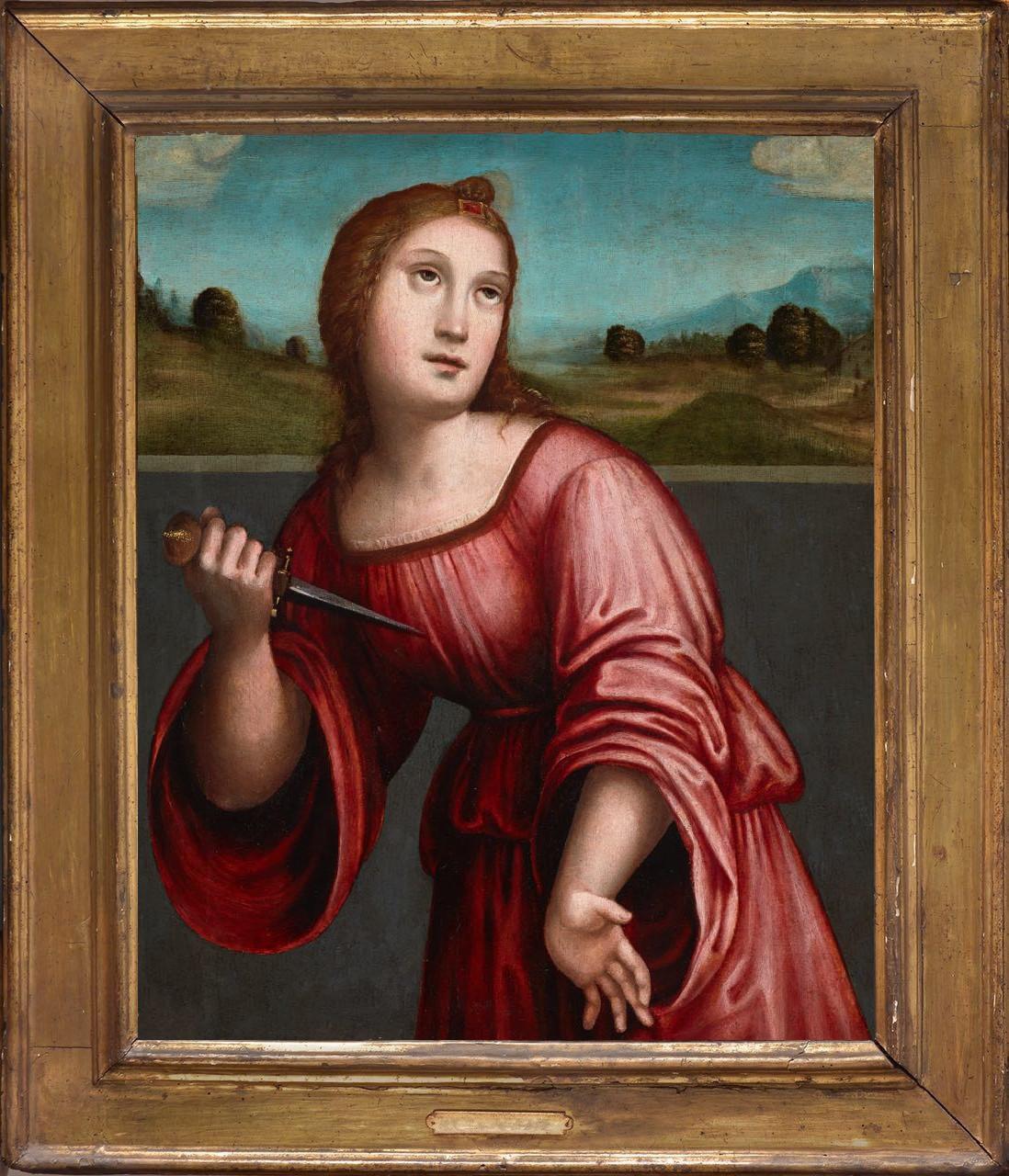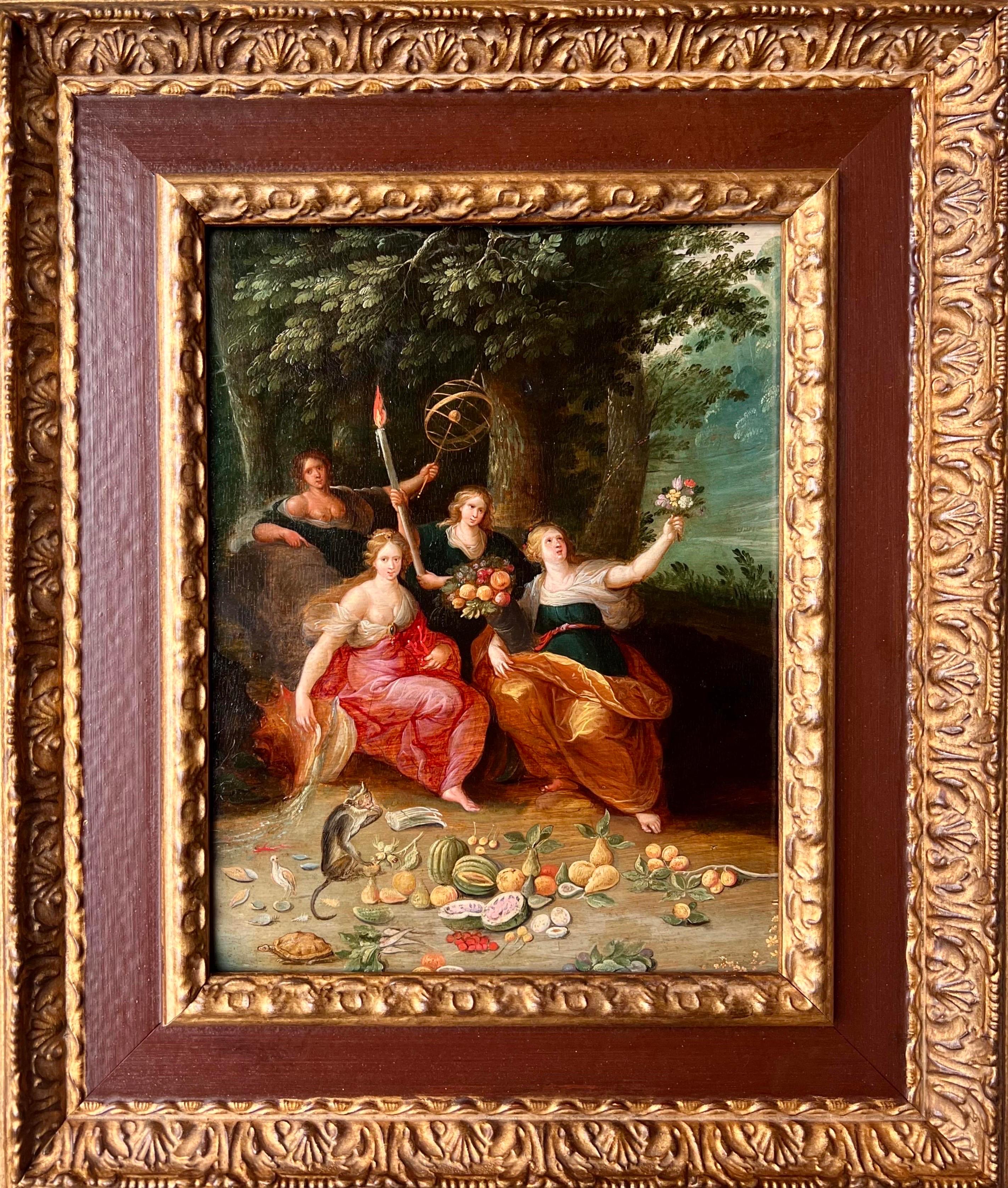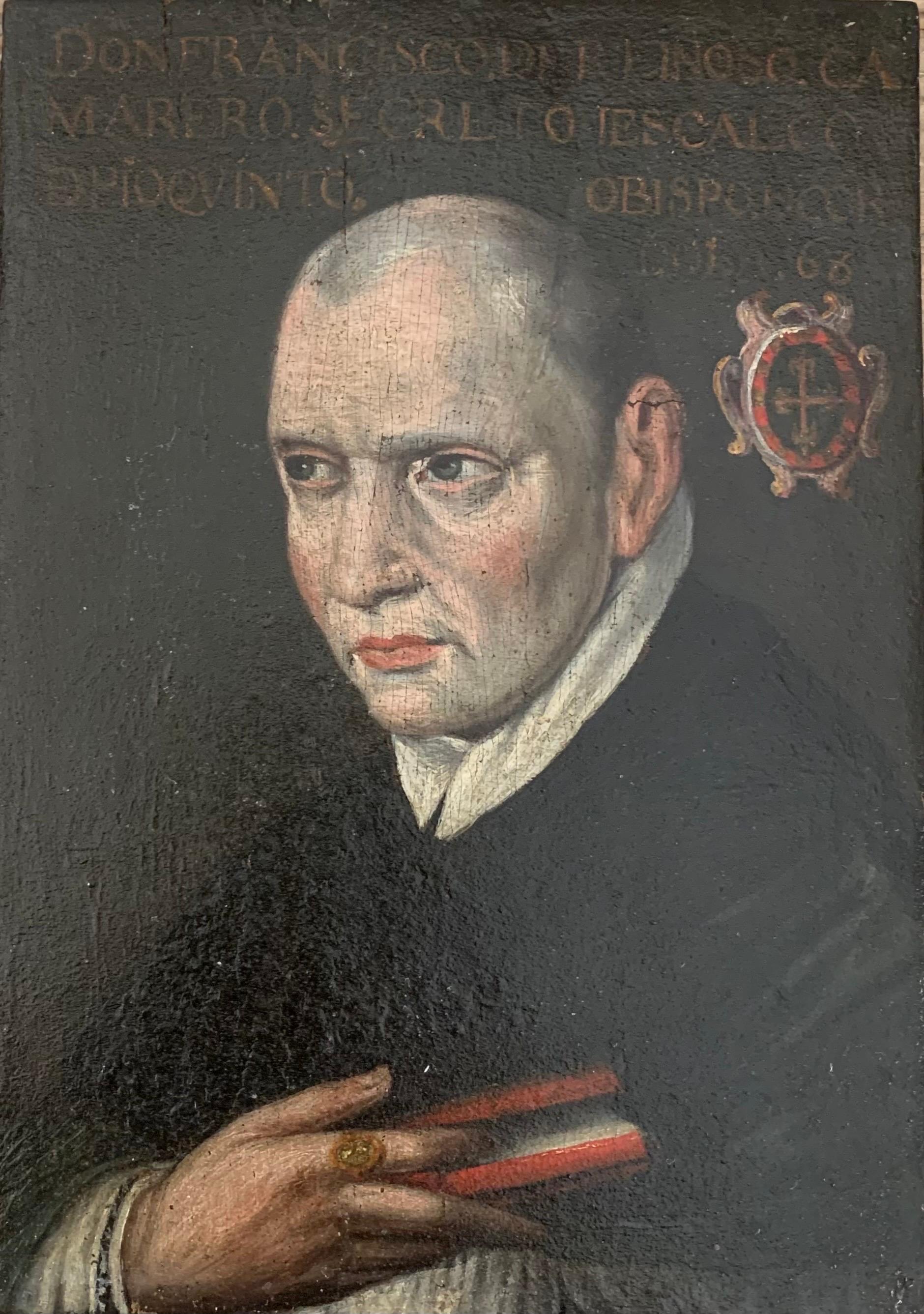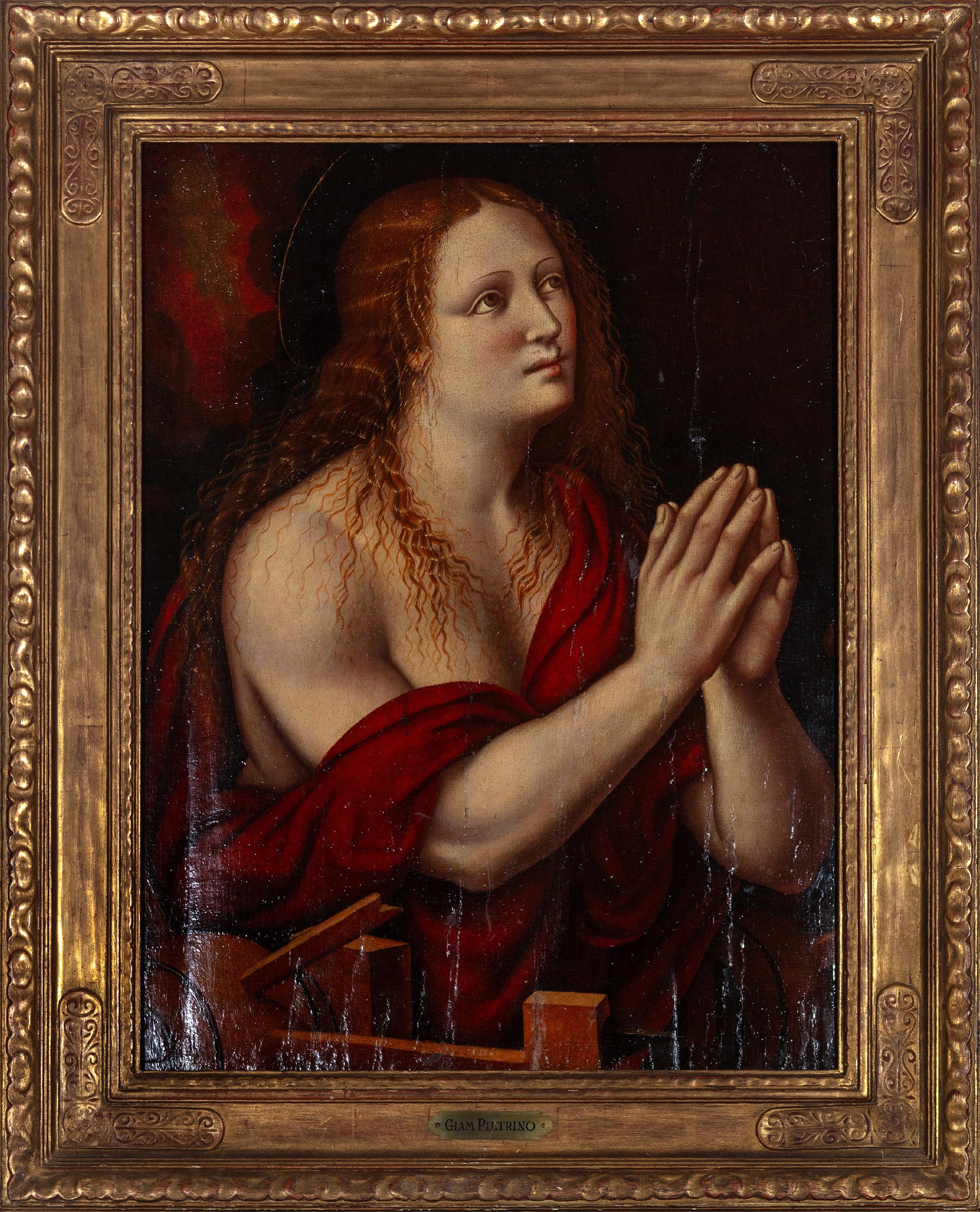Items Similar to Portrait Of A Gentleman By Frans Hals
Want more images or videos?
Request additional images or videos from the seller
1 of 9
Frans HalsPortrait Of A Gentleman By Frans HalsCirca 1630
Circa 1630
About the Item
Frans Hals
1582-1666 Dutch
Portrait of a Gentleman
(possibly Theodore Blevet)
Oil on panel
“Frans Hals is a colourist among the colourists...Frans Hals must have had twenty-seven blacks.”
-Vincent van Gogh writing of Frans Hals’ genius in a letter to his brother Theo
Letter 536, 20 October 1885.
This masterful and rare oil painting by Frans Hals is a quintessential portrait of the Dutch Golden Age. Painted circa 1630, this portrait is exemplary of Hals’ celebrated oeuvre and has been verified as an authentic work by the world’s foremost Hals scholars, including the former and current chief curators of the Frans Hals Museum.
Calm, austere and decorous, the portrait depicts a man turning to meet the viewer's gaze. Wearing a dark cloak with a pleated white collar, the sitter holds a quill in his right hand – perhaps indicating his profession as a writer or calligrapher. The canvas is marked with an inscription that reads “He is 30 years old” in Latin.
Imbued with a sense of genteel kindness, Hals renders the sitter’s expressive face with his signature bold, impressionistic brushwork, painting the sitter’s bone structure with a level of realism and precision that naturalistically captures his likeness along with a glimmer of his personality too. This composition also showcases Hals’ remarkable approach to color whilst working with the deceptively simple palettes of the era. In the Post-Reformation Calvinist society, Dutch elites stood at a delicate balance of boasting the fruits of the Dutch East India Company through both their attire and possessions, while also appearing moral and restrained. Thus, virtuosic painters like Frans Hals would render the dark, yet richly textured fabrics of his sitters with a certain air of inconspicuous luxury in an effort to simultaneously conceal and highlight the sitters’ great taste and wealth. Scholars surmise that this portrait of a black cloak and white collar-clad man likely captures calligrapher and schoolmaster Theodore Blevet, noting the sitter’s resemblance to an engraving of Blevet by Theodor Matham done after a lost 1640 portrait by Frans Hals.
This portrait is an unequivocal triumph of Dutch Golden Age portraiture and an exemplary showpiece of Hals’ esteemed oeuvre. It perfectly showcases the technical acuity and emotional intelligence Hals brought to his works, underscoring his mastery over the medium of oil painting and the genre of portraiture.
Frans Hals’ works grace the walls of the most renowned museums in the world including the Rijksmuseum, the Louvre, the Metropolitan Museum of Art and Hals’ namesake museum in Haarlem in the Netherlands. Hals’ compositions are instantly recognizable by both art connoisseurs and casual museum-goers alike. Hals, Rembrandt and Vermeer are regarded as the crowning trifecta of painters of the Dutch Golden Age, with Hals specifically holding court as the leader in the realm of portraiture. Scholars today praise Hals as decisively ahead of his time, noting the groundbreaking sense of modernity in his 17th-century works. Hals’ triumphant ability with portraiture has been the subject of several seminal exhibitions mounted at institutions including the Metropolitan Museum of Art, The National Gallery of Art and The Wallace Collection.
Circa 1630
Canvas: 17 1/2” high by 14 1/4” wide
Framed: 25 1/2” high by 23 3/8” wide
Exhibited:
The Hague, Schilderkundig Genootschap Pulchri Studio, Catalogue de la Collection Goudstikker d'Amsterdam, November 1919, no. 50, illustrated, as Frans Hals
Amsterdam, Maatschappij voor Beeldende Kunst, Catalogue de la Collection Goudstikker d'Amsterdam, 14 December 1919-4 January 1920, no. 28, illustrated, as Frans Hals
Copenhaguen, Staaten's Museum for Konst, Collection Goudstikker d'Amsterdam, January-February 1920, no. 24, illustrated, as Frans Hals
Christiania [Oslo], Utstillet Christiania Kunstforening, Katalog over Goudstikkers Samling Amsterdam, April 1920, no. 24, illustrated, as Frans Hals
St. Louis, City Art Museum, November 1922, no. 45, as Frans Hals
Detroit, The Detroit Institute of Arts, January 1923, no. 2, as Frans Hals
New York, The Anderson Galleries, March 1923, no. 48 as Frans Hals
Rotterdam, Rotterdamsche Kunstkring, Catalogue de la Collection Goudstikker d'Amsterdam, 20 December 1924-11 January 1925, no. 30, as Frans Hals
Utrecht, Centraal Museum, December 1925-January 1926, no. as Frans Hals1
The Hague, Schilderkundig Genootschap Pulchri Studio, Catalogue de la Collection Goudstikker d'Amsterdam, 13 March-4 April 1926, no. 66, illustrated, as Frans Hals
Rotterdam, Rotterdamsche Kunstkring, Catalogue de la Collection Goudstikker d'Amsterdam, 10-25 April 1926, no. 43, as Frans Hals
Amsterdam, Rijksmuseum, Tentoonstelling van oude Kunst, 1929, no. 61, as Frans Hals
Rotterdam, Rotterdamsche Kunstkring, Catalogus der Tentoonstelling van Schilderijen en Antiquiteiten geexposeerd door den Kunsthandel J Goudstikker NV., Amsterdam, 17December 1936-10 January 1937, no. 26, illustrated, as Frans Hals
Haarlem, Frans Hals Museum, Tentoonstelling van oude kunst in het Frans Halsmuseum, 4-26 April 1936, p. 17, no. 17, as Frans Hals
Haarlem, Frans Hals Museum, Frans Hals tentoonstelling ter gelegenheid van het 75-jarig bestaan van het Gemeentelijk Museum Haarlem, 30 June 1937, no. 38, fig. 38, as Frans Hals
Literature:
W.R. Valentiner, 'Frans Hals, des Meisters Gemalde', in Klassiker der Kunst, Stuttgart/Berlin, 1921, p. 80, illustrated, p. 311 as Frans Hals
W.R. Valentiner, 'Frans Hals, des Meisters Gemalde', in Klassiker der Kunst, Stuttgart/Berlin, 1923, p. 83, illustrated, p. 312 as Frans Hals
C. Grimm, France Hals and his Workshop, will be published in Autumn 2023, no. A3. 13, as Frans Hals
Provenance:
Friedrich W.R.A. Lippmann, Berlin and London
Jacques Goudstikker, Amsterdam by 1919
Looted by the Nazi authorities in July 1940
Recovered by the Allies in 1945
In the custody of the Dutch Government
Restituted to the heir of Jacques Goudstikker in February 2006
Sale Christie's Amsterdam, 14 November 2007, lot 4
Private Collection, USA
M.S. Rau, New Orleans
- Creator:Frans Hals (Dutch)
- Creation Year:Circa 1630
- Dimensions:Height: 25.5 in (64.77 cm)Width: 22.38 in (56.85 cm)Depth: 2.75 in (6.99 cm)
- Medium:
- Movement & Style:
- Period:
- Condition:
- Gallery Location:New Orleans, LA
- Reference Number:
About the Seller
5.0
Vetted Seller
These experienced sellers undergo a comprehensive evaluation by our team of in-house experts.
Established in 1912
1stDibs seller since 2013
15 sales on 1stDibs
Typical response time: 3 hours
- ShippingRetrieving quote...Ships From: New Orleans, LA
- Return PolicyThis item cannot be returned.
More From This SellerView All
- Virgin and Child with the Infant Saint JohnBy Domenico PuligoLocated in New Orleans, LAA masterful example of Italian Mannerist painting, this exceptional panel was composed by the renowned Florentine painter Domenico Puligo. Alongside Jacopo Pontormo and Rosso Fiorentino, Puligo is remembered as one of the foremost figures of the Mannerist movement that rose to prominence during the 16th century in Florence. This panel of the Virgin Mary with the Christ child and Saint John the Baptist is a characteristic example of his celebrated devotional images, which grace museums such as the Metropolitan Museum of Art (New York), Museo del Prado (Madrid), Palazzo Borghese (Rome), and Palazzo Pitti (Florence), among many others. Puligo’s skill with color is fully demonstrated in the beautifully preserved work. Considering its age, the vibrancy and the sheer range of color is remarkable. The Virgin Mary’s crimson dress...Category
16th Century Mannerist Portrait Paintings
MaterialsOil, Panel
- Josianna, Jeune Femme au Ruban by Jean Gabriel DomergueBy Jean-Gabriel DomergueLocated in New Orleans, LAJean-Gabriel Domergue 1889-1962 French Josianna, jeune femme au ruban (Josianna, Young Woman With Ribbon) Signed "Jean Gabriel Domergue" (lower left) Oil on panel A young French beauty known as Josianna is the subject of this work by Jean-Gabriel Domergue, and the oil on panel is a perfect example of the portraits for which the artist is renowned. His model embodies the concept of the la belle Parisienne: slender, swan-like women bearing an unmistakable grace and style. Domergue includes a delicate pink ribbon around her neck, suggesting a fashionable garment, set against a soft pastel-colored backdrop. The artist's oeuvre encompasses women from all facets of society, from aristocratic figures such as Liane de Pougy and Nadine, Baroness de Rothschild...Category
20th Century Post-Impressionist Figurative Paintings
MaterialsPanel, Oil
- Blackstone CigarsBy Norman RockwellLocated in New Orleans, LAA charming relic of a bygone era, this rare oil is the work of the inimitable American illustrator, Norman Rockwell. The iconic artist’s ability to render the details and nuances of ...Category
Early 20th Century Other Art Style Figurative Paintings
MaterialsOil, Canvas
- La lecture au jardin (Lesson in the Garden)By Georges d'EspagnatLocated in New Orleans, LAFrench Post-Impressionist painter Georges d’Espagnat captures a charming moment between a mother and her child in this vibrant oil on canvas. Rendered with a studied use of complementary colors and bold brushstrokes, the painting showcases the artist's unique Post-Impressionist style. Remembered as one of the most individualistic artists of the 20th century, his distinctive canvases bring together the loose brushwork of the Impressionists and the bold color palette favored by the Fauves. Together, they achieve a vibrant spontaneity that lends itself well to the carefree subjects of the present work. Masterfully composed, La lecture au jardin moves beyond the Impressionist instinct to capture a fleeting moment on canvas. Rather, d'Espagnat succeeds in creating a deep feeling of harmony in the work. Warm colors are perfectly balanced with cool tones, while vertical and horizontal lines are softened by the curves of the foliage and his subjects' figures. Through his simplification of forms and intentional use of color and line, he creates a scene that is carefully designed and thoroughly modern. A similar view of a mother and her child by d'Espagnat is currently in the collection of the Metropolitan Museum of Art (New York). The Post-Impressionist painter was an individualist since his youth, choosing to forgo traditional schooling in order to independently study the Old Masters in the Louvre. He soon became involved with the most prominent Impressionist and Post-Impressionist painters of the age, including Pierre-Auguste Renoir and Paul Signac, who themselves existed outside the traditional norms of French Academic training. In 1891, he exhibited at the Salon des Refusés, and again the following year at the Salon des Indépendants. By 1895, he held his first one-man show in Paris, and just three years later his success earned him a solo show at the prestigious Durand-Ruel Gallery. Between 1905 and 1910 he made several trips to visit Renoir on the Côte d’Azur. Their close friendship resulted in a group exhibition at Marcel Bernheim...Category
Late 19th Century Post-Impressionist Portrait Paintings
MaterialsCanvas, Oil
- Egg Tapping On Easter Sunday By Hubert RitzenhofenLocated in New Orleans, LAHubert Ritzenhofen 1879-1961 German Egg Tapping on Easter Sunday Signed and dated "H. Ritzenhofen 05" (lower right) Oil on canvas This grand domestic tableau was painted by estee...Category
20th Century Figurative Paintings
MaterialsCanvas, Oil
- A Pompeian LadyBy John William GodwardLocated in New Orleans, LAJohn William Godward 1861-1922 British A Pompeian Lady Signed and dated "J.W. Godward 1904" (lower right, partially covered by frame) Oil on canvas One of the last and greatest Victorian neoclassical painters, John William Godward is celebrated for his flawlessly executed images of graceful women posed in idealized ancient settings. In this work, entitled A Pompeian Lady, a classical beauty is caught idling in a moment of quiet, solitary reflection. Godward's elegant subjects are depicted with a degree of technical mastery that remains unsurpassed, and the work's dramatic palette, luxurious fabrics and classical vision are all characteristics of his unique take on the neoclassical style. Godward was unmatched in terms of his technical skill and attention to detail. A master of contrasting textures, he paints a diaphanous gown draping against the model’s smooth, milky white skin, which sits against the painstakingly rendered individual hairs of a tiger’s pel. Scintillating color permeates the canvas as well, energizing the otherwise static scene. Each element is given careful attention, and the overall effect is one of both immaculate technique and sensual tactility. Along with his contemporary and mentor, Sir Lawrence Alma-Tadema, Godward set the tone for the Victorian neoclassicist movement. He built his career upon creating images of idealized feminine beauty infused with a Greco-Roman-inspired style. Though greatly influenced by Alma-Tadema, Godward distinguished himself through his predilection for the solitary female figure. His fame rose dramatically in the first few years of the 20th century, when the present work was completed, due to the burgeoning strength of the British Empire and the Victorian society’s preoccupation with ancient Rome. To many of the newly affluent, Roman society was, as Iain Gale writes, “a flawless mirror of their own immaculate world.” The sensuality and mystery of Godward’s maidens, combined with his impressive antique backdrops...Category
Early 20th Century Academic Portrait Paintings
MaterialsOil, Canvas
You May Also Like
- Lucretia, by Giacomo Raibolini Francia. Detto il Francia. Oil on panel, framedLocated in Brooklyn, NYGiacomo used to paint with his brother Giulio, identifying their works with the monogram «I I». The strong influence of his father, Francesco, is undeniable in all his works, althoug...Category
16th Century Old Masters Figurative Paintings
MaterialsOil, Wood Panel
- 17th century Allegory of the four Elements - Frans Francken the Younger FlemishBy Frans Francken IILocated in Antwerp, BEVery fine 17th century Flemish old master "Allegory of the four elements" attributed to Frans Francken the Younger The figures are the Nereid Amphitrite, holding a coral and represe...Category
17th Century Old Masters Figurative Paintings
MaterialsOil, Panel
- Spanish school. Secretary of Pope Pius V, abbot of Husillos, bishop of Córdoba.Located in Firenze, ITPortrait of Francisco de Reynoso y Baeza. Secretary of Pope Pius V, abbot of Husillos and bishop of Córdoba. Francisci de Reynoso. Early 17th century. Small-format portrait from the late Renaissance period. Spanish school. Size: Cm 19 x Cm 13.5 Oil on wooden panel. On the back the fine tablet is strengthened (already in ancient times) by a sheet of parchment. About 1600-1610. As often in Mannerist / Late Renaissance portraits, the image of the character is accompanied by the writing that runs at the top, adding a celebratory, historicising touch to the effigy. Let's bring back the sentence here: DON FRANCISCO DE REINOSO. CAMARERO SECRETO IESCALCO PIO QUINTO OBISCOPO CORDOBA. 68 (? O 7?) (1534, Autillo de Campos, Spain - 1601, Córdoba) Francisco de Reynoso was a Spanish cleric, chief chamberlain, and secretary to Pope Pius V, abbot of Husillos, and bishop of Córdoba. He was the fourth of eleven children. His father was the seventh Lord of Autillo de Campos, and his mother was Juana de Baeza y de las Casas, daughter of Manuel de Baeza, a lawyer of the Royal Council and at the Court of Valladolid. Francisco de Reynoso was deeply devoted to the Virgin Mary and showed a strong inclination toward religion and piety from an early age. He studied Latin, arts, and theology at the University of Salamanca. In 1562, he traveled to Rome with his brothers Pedro and Luis. In January 1566, following the death of Pope Pius IV, Cardinal Antonio Michele Ghislieri was elected pope, becoming Pius V. From this period until Ghislieri's death in 1572, Francisco de Reynoso served as his chief chamberlain and secretary. After Pope Pius V died, Francisco de Reynoso returned to Spain and lived for several years in the city of Palencia, where his brother Manuel was a canon. He supported the Society of Jesus when it was established in Palencia, providing alms to the school's clergy and funding chairs of Letters and Theology at his own expense, as well as donating a significant number of books. During the brief outbreak of the Black Plague...Category
17th Century Old Masters Portrait Paintings
MaterialsParchment Paper, Oil, Wood Panel
- Portrait of a ManLocated in New York, NYProvenance: with Leo Blumenreich and Julius Böhler, Munich, 1924 Dr. Frederic Goldstein Oppenheimer (1881-1963), San Antonio, Texas; by whom given to: Abraham M. Adler, New York, until 1985; thence by descent to the present owners While old inscriptions on the verso of this panel propose its author to be Hans Holbein and the sitter Sir John More—a lawyer, judge, and the father of Sir Thomas More—this fine portrait has long been recognized to be by a Flemish hand. Max Friedländer gave the painting to Bernard van Orley (1487/1491 – 1541) in 1924, but did not include it in the volume dedicated to the artist in his Early Netherlandish Paintings...Category
16th Century Old Masters Portrait Paintings
MaterialsOil, Panel
- Large 17th Century Dutch Old Master Oil Painting on Wood Panel Biblical SceneLocated in Cirencester, GloucestershireBiblical Figures, Large Gathering around Christ? Dutch Old Master, early 17th century oil painting on wood panel, stuck on velvet backing board velvet board: 27 x 29 inches board: 25.5 x 26 inches provenance: private collection, France condition: good and sound condition, obvious old panel...Category
Early 17th Century Old Masters Figurative Paintings
MaterialsWood Panel, Oil
- 19th century classical religious oil painting portrait female subject red darkBy (After) GiampietrinoLocated in Milwaukee, WI"Caterina d'Alexandria (Saint Catherine of Alexandria)" is an original oil painting on wood panel, likely painted by Italian artist Giampietrino (Giovanni Pietro Rizzoli). The painti...Category
19th Century Old Masters Portrait Paintings
MaterialsOil, Wood Panel
Recently Viewed
View AllMore Ways To Browse
Portraits 20 Century
Portrait Of A Black Man
Golden Frame Portrait
Antique Hand Paint Portrait
Antique Gentleman
1919 Portrait
Old Man A S
Golden Age Portrait
Portrait Of An Old Man
24 By 48 Art
A R Antiques
Authentic Antique Frames
Old Man Face
Antique Fabric Panel
Dutch Old Master Portrait
Antique 4 Panel Door
Antique 4 Panel Doors
Oil Painting 1940s Portrait





